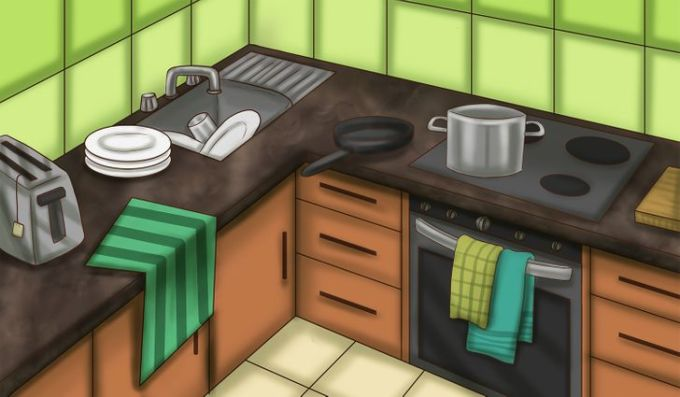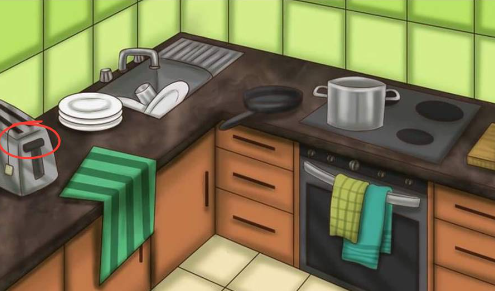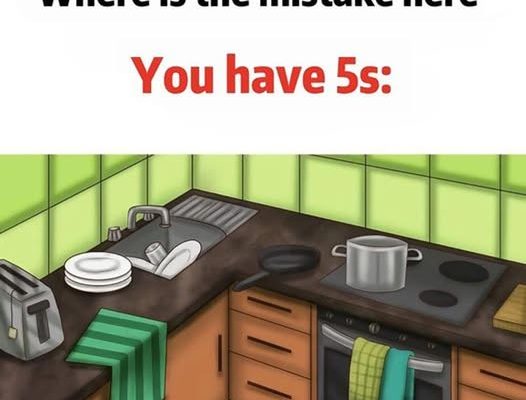When it comes to puzzles and brain teasers, they’re not just a way to pass the time—they’re excellent for honing your attention to detail and critical thinking skills. Today, we’re diving into a particularly engaging visual challenge. At first glance, this image of a seemingly ordinary kitchen looks completely normal. But here’s the twist: something doesn’t belong. Can you spot the mistake?
Why This Puzzle Is a Perfect Test for Observation

This isn’t your typical “spot-the-difference” game. It’s a challenge that taps into how we perceive everyday surroundings. The image of the kitchen contains all the usual suspects—a toaster, a sink, pots, and dish towels. Yet, something is off, and it’s up to you to figure out what it is.
Common Mistakes When Solving Visual Puzzles
If you’re struggling to spot the error right away, don’t worry—you’re not alone. Many people find these puzzles tricky because of a few common pitfalls:
1. Overlooking Familiar Objects
Your brain is programmed to process familiar environments quickly. Kitchens are everyday spaces, so you might breeze past details, assuming everything is in its rightful place.
2. Focusing on the Wrong Areas
Sometimes, solvers get stuck analyzing unimportant details, like the cabinet handles or the tiles, while the actual mistake is hiding in plain sight.
3. Missing the Out-of-Context Item
The key to solving this puzzle lies in spotting the one thing that doesn’t belong. Kitchens are full of expected items, so an unusual element can blend in surprisingly well.
Now that we’ve outlined the challenges, let’s break this down step by step to uncover the mistake.
Breaking It Down: A Step-by-Step Approach
To solve this puzzle, let’s methodically examine different parts of the kitchen:
The Sink and Countertop
At first glance, the sink looks perfectly normal. You’ll see a stack of plates, some utensils, and neatly folded towels. Everything checks out here.
The Stovetop and Pots
Moving on to the stove, we find a pot and a frying pan. These are standard items you’d expect to find in any kitchen. Still no sign of anything out of place.
The Toaster
Here’s where things get interesting. On the countertop sits a toaster—a common kitchen appliance. But if you look closer, you’ll notice something unusual inside the toaster: a tea bag.
The Mistake Revealed: A Tea Bag in the Toaster
That’s right—the mistake is the tea bag sitting inside the toaster! While a toaster is meant for bread, bagels, or even waffles, it’s definitely not the place for a tea bag. This tiny, seemingly innocent detail is what makes the puzzle so clever. It’s subtle enough to escape notice but odd enough to stand out once you see it.
Why This Puzzle Was So Tricky
This visual brain teaser relies on our natural tendencies to overlook certain details. Here’s why spotting the tea bag in the toaster wasn’t as easy as it seems:
It Looks Normal at First Glance
The tea bag doesn’t scream “out of place” right away. Your brain might gloss over it as just another small object in the kitchen.
Our Minds Fill in the Gaps
When we see a familiar scene, like a kitchen, our brains assume everything belongs. This mental shortcut often causes us to overlook small discrepancies.
Visual Clutter
The image is filled with typical kitchen items, making it easy to get distracted by the overall scene rather than focusing on individual objects.
How to Sharpen Your Observation Skills
If this puzzle caught you off guard, don’t worry—it’s a great opportunity to improve your observation skills. Here are a few tips to help you spot details like a pro:
1. Slow Down
Instead of rushing through, take your time to carefully analyze each part of the image. Methodical observation often reveals what’s hidden.
2. Question the Context
Ask yourself whether each item belongs in the scene. If something feels out of place, don’t dismiss it—investigate further.
3. Practice Makes Perfect
The more you engage with puzzles and visual challenges, the sharper your observational skills will become. It’s like exercising a muscle—the more you use it, the stronger it gets.
What Did You Spot First?

So, did you catch the tea bag in the toaster right away, or did it take you a few moments to find it? Either way, puzzles like these are a fun and rewarding way to test your brain. Share your experience—what drew your attention first? Did you focus on the sink, the stove, or the toaster?
Why Visual Puzzles Are Great for Your Brain
Challenges like this do more than just entertain—they’re excellent mental workouts. Solving puzzles boosts critical thinking, sharpens attention to detail, and even enhances memory. Think of it as a fun way to keep your brain sharp and engaged.
Conclusion: The Power of Observation
This visual puzzle reminds us of the importance of paying attention to detail. Whether it’s spotting a tea bag in a toaster or noticing subtle changes in your surroundings, being observant is a skill that serves us well in all areas of life.
So, next time you come across a challenge like this, slow down, take a closer look, and enjoy the process. After all, life’s little mysteries are what keep things interesting—and sometimes, the answer is right in front of you, waiting to be discovered.





